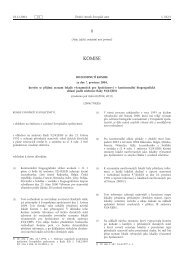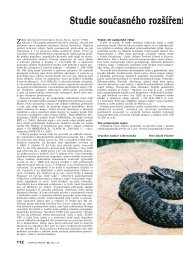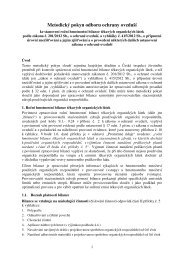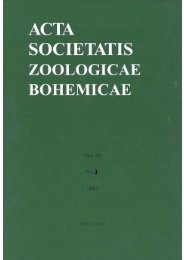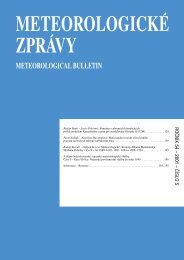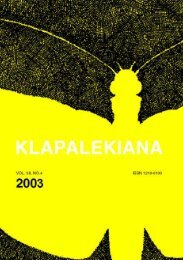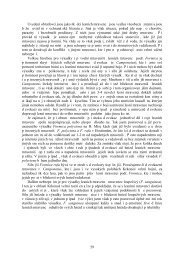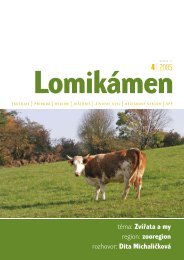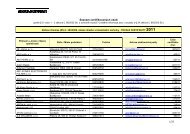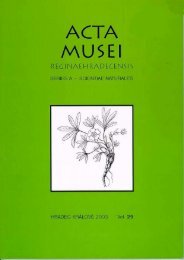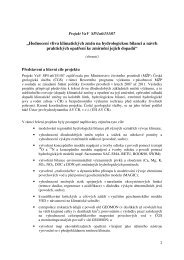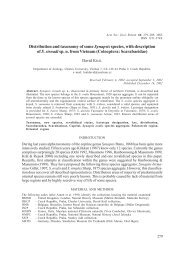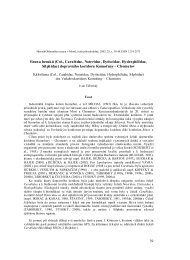journal of forest science
journal of forest science
journal of forest science
Create successful ePaper yourself
Turn your PDF publications into a flip-book with our unique Google optimized e-Paper software.
The influence <strong>of</strong> different methods <strong>of</strong> autoclaving and dating <strong>of</strong><br />
measurement on the rate <strong>of</strong> electrolyte leakage from oak tap root<br />
M. SARVAŠ<br />
Forestry Research Institute, Zvolen, Slovak Republic<br />
The plant quality is a complicated complex <strong>of</strong> traits<br />
which in their interaction influence survival and growth.<br />
There are some simple methods (measurements <strong>of</strong> morphological<br />
parameters) to determine external damage <strong>of</strong><br />
planting stock. But physiological quality plays a decisive<br />
role in successful survival and regrowth <strong>of</strong> plants<br />
after af<strong>forest</strong>ation.<br />
Besides plant damage, the physiological quality is influenced<br />
by other factors too. These factors very significantly<br />
influence key traits <strong>of</strong> planting stock quality. The<br />
nursery practice (undercutting, transplantation) has a considerable<br />
effect on root growth potential, different regimes<br />
<strong>of</strong> cold storage influence water content in plant<br />
tissues, and very important role is played by the end and<br />
beginning <strong>of</strong> dormancy which influence mitotic index<br />
and chlorophyll florescence.<br />
The measurement <strong>of</strong> electrolyte leakage is one <strong>of</strong> the<br />
methods which is very <strong>of</strong>ten used for finding the actual<br />
physiological planting stock quality. DEXTER et al.<br />
(1932) described a principle <strong>of</strong> this method for the first<br />
time. In his study he concluded that the injury or killing<br />
<strong>of</strong> tissue, by cold or by any other means, involves the<br />
disorganization <strong>of</strong> the substances essential for carrying<br />
on the processes <strong>of</strong> life. With such disorganization, it is<br />
well recognized that the cell loses its capacity to regulate<br />
the diffusion <strong>of</strong> its soluble contents. Upon this basis, it<br />
was assumed that the degree <strong>of</strong> injury from low temperature<br />
to overwintering and other plant structures might<br />
be correlated with the exosmoses <strong>of</strong> electrolytes and<br />
other material following exposure to cold. PALTA et al.<br />
(1977) writes that electrolyte leakage is an index <strong>of</strong> the<br />
JOURNAL O OREST SCIENCE, 47, 2001 (7): 301–306<br />
ABSTRACT: In this study sensitivity <strong>of</strong> the method <strong>of</strong> measurement <strong>of</strong> electrolyte leakage from oak tap root was examined.<br />
The influence <strong>of</strong> different intervals <strong>of</strong> measurement after stress treatment on the rate <strong>of</strong> electrolyte leakage was<br />
studied. The results showed that the rate <strong>of</strong> electrolyte leakage decreased in time after frost treatment (after 2 months by<br />
100%). On the other hand, after desiccation treatment the rate <strong>of</strong> electrolyte leakage was the same. The rate <strong>of</strong> electrolyte<br />
leakage can be influenced not only by injury <strong>of</strong> cells but also by the methodology <strong>of</strong> measurement and therefore it is problematic<br />
to make a comparison <strong>of</strong> results obtained by different methods <strong>of</strong> measurement. It is necessary to use the same<br />
method <strong>of</strong> measurement for all variants.<br />
Keywords: electrolyte leakage; physiological quality <strong>of</strong> planting stock; oak bare-rooted seedlings; tap root<br />
semi-permeable properties <strong>of</strong> the cell membranes. MC-<br />
KAY (1998) wrote that if fine roots are capable <strong>of</strong> maintaining<br />
a low level <strong>of</strong> electrolyte leakage it is probable<br />
that they would also be capable <strong>of</strong> water uptake.<br />
The ability <strong>of</strong> cell membranes to control the rate <strong>of</strong> ion<br />
movement in and out <strong>of</strong> cells is used as a test <strong>of</strong> damage<br />
for a great range <strong>of</strong> tissue samples from seeds (SAHLÉN,<br />
GJELSVIK 1993), roots (MCKAY 1992, 1993, 1998; SAR-<br />
VAŠ 1998, 1999; SCHÜTE, SARVAŠ 1999), needles (BURR<br />
et al. 1990), stems (DEANS et al. 1995). Some works used<br />
the rate <strong>of</strong> electrolyte leakage from needles or shoots to<br />
determine frost hardiness (COLOMBO, HICKIE 1987;<br />
MURRAY et al. 1989). TINUS (1996) and TINUS and<br />
BURR (1997) used measurements <strong>of</strong> electrolyte leakage<br />
from needles to determine the time <strong>of</strong> autumn seedling<br />
lifting for cold storage and their results showed that there<br />
was indeed a relationship between cold hardiness at the<br />
time <strong>of</strong> lifting and field survival <strong>of</strong> white and red pine,<br />
but this relationship for Norway spruce was more complex.<br />
In general, several studies have concluded the possibility<br />
to find physiological quality <strong>of</strong> planting stock by<br />
measurements <strong>of</strong> electrolyte leakage. Unfortunately, it is<br />
problematic to make a comparison <strong>of</strong> separate results.<br />
Some works have used for testing samples from fine roots<br />
(MCKAY 1992, 1993, 1998; MCEVOY, MCKAY 1997;<br />
KERR, HARPER 1992), tap root (SARVAŠ 1998, 1999;<br />
SCHÜTE, SARVAŠ 1999), stem (COLOMBO et al. 1984;<br />
DEANS et al. 1995) and needles (TINUS 1996). There is<br />
a difference in medium in which the samples are placed<br />
during autoclaving (SARVAŠ 1998, 1999; MURRAY et al.<br />
J. FOR. SCI., 47, 2001 (7): 301–306 301



